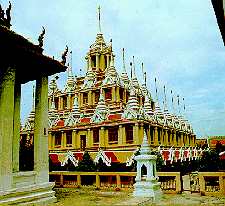
Prasat Phra Thep Bidon or the Royal Pantheon built on cruciform plan with four porticoes and prang-shaped spire.
The top of the spire adorned with glazed tiles. The front portico at the east side is an open two-level hall.
The gable is in gilded and decorated with glasses. On the front terrace stand mythical figures call "kinnon", cast in metal. , Bangkok
This structure too is a direct descendant of the Greek-cross-planned Khmer temple composed by a square sanctuary with its domical sikhara and the four
porch-like antechambers attached to the sides of the cell. It is interesting to note that these antechambers projecting from the main body of the building have two different
elements : one formed by the mass attached to the walls of the cell, the other formed by the portal. If we observe the profile line we note that the different heights of these
two elements design a step-like contour. In the timber roof of the Thai buildings, the stepped outline is still more noticeable on account of addition of projecting masses
and also on account of superimposed layers of the roofs.

Loha Prasat , Wat Ratchanatdaram, Bangkok
The Thai Pra Sat is formed in plan by a square central room with three projecting long wings and one short, or may have the four wings of the same length.
There are two distinct froms of timber superstructure of the Pra Sat. One retaining the traditional sikhara as finial of the roofs ; in this type we note that for the sake
of tradition the sikhara, which formerly was structural, has become a mere decorative part of the building. The other superstructure has the same form and same
ornaments as that of the Mondop, namely, many, superimposed horizontal low storeys and at about one thrid of the total height of this elaborated roof a vertical
element fromed by what looks a conventional stupa ending in a very high and thin pinnacle.
The Pra Sat serves two distinct purposes : one as the royal throne hall ; the other to contain some venerated objects such as the Pra Sat of
Wat Phra Kaeo in Bangkok which enshrines the statues of the Kings of the present dynasty.
|

